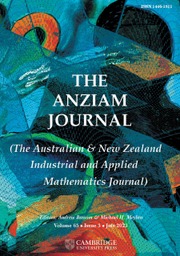Crossref Citations
This article has been cited by the following publications. This list is generated based on data provided by Crossref.
Hill, James M.
1977.
Generalized shear deformations for isotropic incompressible hyperelastic materials.
The Journal of the Australian Mathematical Society. Series B. Applied Mathematics,
Vol. 20,
Issue. 2,
p.
129.
Agarwal, V. K.
1979.
On finite anti-plane shear for compressible elastic circular tube.
Journal of Elasticity,
Vol. 9,
Issue. 3,
p.
311.
Knowles, James K.
1979.
Universal States of Finite Anti-Plane Shear: Ericksen's Problem in Miniature.
The American Mathematical Monthly,
Vol. 86,
Issue. 2,
p.
109.
Knowles, James K.
1979.
On the dissipation associated with equilibrium shocks in finite elasticity.
Journal of Elasticity,
Vol. 9,
Issue. 2,
p.
131.
Horgan, C. O.
and
Knowles, J. K.
1981.
The effect of nonlinearity on a principle of Saint-Venant type.
Journal of Elasticity,
Vol. 11,
Issue. 3,
p.
271.
Abeyaratne, Rohan
1981.
Discontinuous deformation gradients away from the tip of a crack in anti-plane shear.
Journal of Elasticity,
Vol. 11,
Issue. 4,
p.
373.
Knowles, James K.
1981.
Proceedings of the IUTAM Symposium on Finite Elasticity.
p.
257.
Gurtin, Morton E.
and
Temam, Roger
1981.
On the anti-plane shear problem in finite elasticity.
Journal of Elasticity,
Vol. 11,
Issue. 2,
p.
197.
Abeyaratne, R.
and
Horgan, C. O.
1983.
Bounds on stress concentration factors in finite anti-plane shear.
Journal of Elasticity,
Vol. 13,
Issue. 1,
p.
49.
Horgan, C. O.
and
Abeyaratne, R.
1983.
Finite anti-plane shear of a semi-infinite strip subject to a self-equilibrated end traction.
Quarterly of Applied Mathematics,
Vol. 40,
Issue. 4,
p.
407.
Horgan, Cornelius O.
and
Knowles, James K.
1983.
Advances in Applied Mechanics Volume 23.
Vol. 23,
Issue. ,
p.
179.
Abeyaratne, Rohan
1984.
Modelling Problems in Crack Tip Mechanics.
p.
3.
Jafari, A.H.
Horgan, C.O.
and
Abeyaratne, R.
1984.
Finite anti-plane shear of an infinite slab with a traction-free elliptical cavity: Bounds on the stress concentration factor.
International Journal of Non-Linear Mechanics,
Vol. 19,
Issue. 5,
p.
431.
Fowler, Graeme Francis
1984.
Finite plane and anti-plane elastostatic fields with discontinuous deformation gradients near the tip of a crack.
Journal of Elasticity,
Vol. 14,
Issue. 3,
p.
287.
Toulios, M.
1985.
The wavefront induced in a homogeneously shearing solid by a localized material imperfection.
Quarterly of Applied Mathematics,
Vol. 43,
Issue. 2,
p.
225.
Tahraoui, R.
1988.
Théorèmes d'existence en calcul des variations et applications à l'élasticité non linéaire.
Proceedings of the Royal Society of Edinburgh: Section A Mathematics,
Vol. 109,
Issue. 1-2,
p.
51.
Horgan, C. O.
and
Payne, L. E.
1989.
On the asymptotic behavior of solutions of inhomogeneous second-order quasilinear partial differential equations.
Quarterly of Applied Mathematics,
Vol. 47,
Issue. 4,
p.
753.
Engler, Hans
1989.
Global regular solutions for the dynamic antiplane shear problem in nonlinear viscoelasticity.
Mathematische Zeitschrift,
Vol. 202,
Issue. 2,
p.
251.
Abeyaratne, Rohan
and
Guo-Hua, Jiang
1989.
Dilatationally nonlinear elastic materials—I. Some theory.
International Journal of Solids and Structures,
Vol. 25,
Issue. 10,
p.
1201.
Ertepinar, Aybar
1990.
On the finite circumferential shearing of compressible hyperelastic tubes.
International Journal of Engineering Science,
Vol. 28,
Issue. 9,
p.
889.

